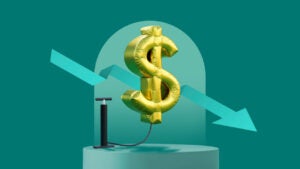8 ways to take penalty-free withdrawals from your IRA or 401(k)

When unexpected expenses pile up and the emergency fund runs dry, where can you turn for money? For many people, their biggest stash of savings is hidden away in retirement plans, such as IRAs and 401(k)s.
But if you withdraw money from a 401(k) or IRA before turning 59½, generally you’ll pay an extra 10% as a penalty. That’s on top of the income taxes you’ll owe.
Luckily, there are some exceptions, such as for certain hardships, that allow for penalty-free withdrawals. You’ll usually still owe income taxes, but at least you’ll avoid the 10% penalty.
1. Unreimbursed medical bills
The government allows savers to withdraw money from their qualified retirement plan to pay for unreimbursed deductible medical expenses that exceed 7.5% of their adjusted gross income.
“You can take a penalty-free withdrawal out of your IRA or 401(k) for the amount that’s above 7.5% of adjusted gross income,” says Carolyn McClanahan, founder of Life Planning Partners in Jacksonville, Fla.
Say your adjusted gross income is $100,000. Then 7.5% of that is $7,500. If your medical expenses are, say, $10,000, you can withdraw $2,500 — that is, the difference between your total medical expenses and 7.5% of your AGI — from your IRA penalty-free. (If your medical expenses add up to less than 7.5% of your AGI, you can’t take advantage of this penalty-free exception.)
To claim your penalty-free withdrawal, you must take the retirement-account withdrawal in the same year that you incurred the medical bills. (You don’t have to itemize deductions to take advantage of this exception to the 10% tax penalty, according to IRS Publication 590.)
2. Disability
The IRS says that investors must be totally and permanently disabled before they can dip into their retirement plans without paying a 10% penalty.
The easiest way to prove disability to the IRS is by collecting disability payments from an insurance company or from Social Security, says Alan Rothstein, a CPA at Rothstein & Co., in Avon, Conn. That said, the IRS says a letter from a doctor, health-care provider or social-services program is acceptable.
3. Health insurance premiums
Penalty-free withdrawals can be taken from an IRA if you’re unemployed and the money is used to pay health insurance premiums. The caveat is that you must be unemployed for 12 weeks.
In case of an audit, Rothstein suggests opening a separate bank account to receive transfers from the IRA and then using it to pay the premiums only. “Or, the best way is to have the money sent to the insurance carrier directly,” he says.
4. If you owe the IRS
If you owe unpaid taxes and the IRS puts a levy on your IRA or 401(k) to collect payment, you can make a penalty-free withdrawal from your retirement account to pay the debt.
5. First-time homebuyers
If you’re a first-time homebuyer (defined by the IRS as someone who hasn’t bought a home in the past two years), you can withdraw up to $10,000 from an IRA penalty-free to use as a down payment for a house.
“If you want to buy a home and you don’t have the money to buy that home, that IRA is an option,” McClanahan says. “The big thing is that, even though you don’t have penalties, you do have to pay income tax.”
For example, if you’re in a 22% tax bracket and you withdraw $10,000 for your first home, you’ll owe $2,200 in taxes.
Generally, while your 401(k) plan may allow you to withdraw down-payment funds as part of a hardship withdrawal, you’re going to owe the 10% penalty if you’re younger than 59½. You could avoid the penalty by asking for a 401(k) loan. But that comes with other risks.
“The problem with borrowing against your 401(k) is that, if you lose your job and you can’t put the money back, you have to pay income tax and a penalty on that,” McClanahan says. “So, I tell people to be very careful about borrowing against your 401(k) because you have to pay it back at some point and if you lose your job before you can pay it back, then you’re going to be hit, not just with taxes, but with a penalty.”
6. Higher education expenses
Similar to a down payment to buy a home, IRA withdrawals for higher education are penalty-free if used to pay for qualified expenses.
What’s more, it doesn’t just have to be for your education, it can be for a family member.
“You can take [money] out for your spouse, you, your grandchildren, your children, but it has to be at an institution that’s accredited,” McClanahan says. “So, you can’t take a yoga class and call it higher education.”
You can take money out of your 401(k) for higher education expenses in two ways:
- as a loan — there’s no penalty if you pay it back, or
- as a hardship withdrawal — but there’s generally no exception for higher education for a 401(k) hardship withdrawal, so you’d be subject to the 10% penalty.
7. Death
When an IRA account holder dies, the beneficiaries can take withdrawals from the account without paying the 10% penalty.
However, the IRS imposes restrictions on spouses who inherit an IRA and elect to treat it as their own. They may be subject to the penalty if they take a distribution before age 59½.
8. For income purposes
Section 72(t) of the tax code allows investors who are younger than 59½ to set up consistent withdrawals from their retirement plans for income, and there are no penalties as long as you follow the rules. (See Bankrate’s 72(t) distributions calculator to see how this provision can help create retirement income.)
Two of the main rules are:
- You must make these payments for a minimum of five years or until you turn 59½, whichever is longer, and
- Once you set up the plan, you can’t make changes.
“With a periodic distribution, you have to take the same amount every year. You can’t vary it,” McClanahan says. “So you need to be pretty clear about what it is that you need so that you can set it up to get the right amount.”
Penalty-free doesn’t mean tax-free
While some situations qualify for a penalty-free early withdrawal from an IRA or a 401(k) plan, it’s important to remember that penalty-free doesn’t mean tax-free:
- Withdrawals from traditional IRA and 401(k) plans made with pre-tax contributions are taxed at ordinary income rates.
- Withdrawals of nondeductible contributions (i.e., those made after-tax) to traditional IRA and 401(k) plans are not subject to the same taxes as deductible contributions, though you’ll still incur taxes on any earnings you withdraw from the accounts.
- Contributions to a Roth IRA can be taken out at any time, and after the account holder turns age 59½ the earnings may be withdrawn penalty-free and tax-free as long as the account has been open for at least five years. The same rules apply to a Roth 401(k), but only if the employer’s plan permits.
In certain situations, a traditional IRA offers penalty-free withdrawals even when an employer-sponsored plan does not. We explain those situations above. Also, be aware that employer plans don’t have to provide for hardship withdrawals at all. Many do, but they may permit hardship withdrawals only in certain situations — for instance, for medical or funeral expenses, but not for housing or education purposes.
Plus, McClanahan says it’s important to remember that, even though an employer might approve borrowing against your 401(k) for a specific expense or hardship, there’s an opportunity cost to withdrawing money from your retirement account.
“If you’re a first-time homebuyer in your 30s and that’s all the money you have, then, by all means, you have plenty of time to work and save it back up,” McClanahan says. “You’ve got to make sure that if you’re taking money out for things like the medical expenses, being a first-time homebuyer, education, etc., that you have a plan and an idea of how you’re going to pay that back.”
And be smart about your choices when it comes to borrowing against your retirement account. Think about the return on investment. “If you’re using it for education — because now you’re going to improve your skills and get a higher paying job — that’s an investment. That makes sense,” McClanahan says.
How to avoid early withdrawals
Tapping your retirement savings should only be used as a last resort. Here are some ways to avoid accessing your 401(k) or IRA early:
Bottom line
Usually, taking an early withdrawal from your 401(k) or IRA means paying an extra 10% penalty on top of income taxes. There are instances where the penalty is waived, but you’ll still pay income taxes on the withdrawal. If possible, try to avoid making withdrawals. And work on building an emergency fund for tough times.
Why we ask for feedback Your feedback helps us improve our content and services. It takes less than a minute to complete.
Your responses are anonymous and will only be used for improving our website.









